Overview
The article underscores the significance of strategies designed to enhance startup hiring velocity, a crucial indicator of organizational growth. It highlights the integration of:
- AI-driven recruitment
- Culture-first hiring
- Network-based recruitment
- Diversity-focused initiatives
These approaches collectively enhance talent acquisition efficiency and align seamlessly with the company's long-term objectives. By adopting these strategies, startups can not only improve their hiring processes but also position themselves for sustainable growth in a competitive landscape.
Introduction
The race to secure top talent has reached unprecedented levels of competition, as startups increasingly recognize that hiring velocity serves as a critical growth indicator. By integrating innovative strategies—such as AI-driven candidate discovery, culture-first hiring, and network-based recruitment—organizations can not only streamline their hiring processes but also elevate the quality of their workforce. Yet, a pressing challenge persists: how can startups effectively balance the urgency of speed with the necessity of thorough candidate evaluation to ensure long-term success? This article delves into ten dynamic strategies that empower startups to enhance their hiring velocity, positioning them for sustainable growth in an ever-evolving marketplace.
Websets: Accelerate Hiring with AI-Driven Candidate Discovery
revolutionizes talent discovery through advanced algorithms, enabling startups to effectively pinpoint and connect with potential hires. By leveraging our AI-driven sales intelligence search, businesses can navigate extensive datasets to accurately identify candidates who meet specific criteria, significantly reducing recruitment time. This technology not only sharpens the accuracy of applicant matches but also enriches profiles with comprehensive details such as LinkedIn profiles, emails, company information, and prior work experiences. Consequently, startups gain access to a wider talent pool, boosting their chances of securing top-tier candidates.
The integration of AI in recruitment processes is increasingly recognized for its ability to simplify candidate selection. A striking 92% of companies report benefits from AI, including substantial productivity gains. Additionally, 89% of HR professionals utilizing AI in recruiting affirm that it saves them time or enhances efficiency. Successful startups have already begun to harness these advancements to refine their recruitment strategies, viewing startup hiring velocity as a growth signal, with 51% of organizations employing AI to bolster their recruiting efforts.
Consider Chipotle's AI assistant 'Ava Cado,' which elevated application completion rates from 50% to 85% and reduced recruitment timelines from 12 days to just 4. However, it is crucial to recognize the necessity of human oversight in AI recruitment to mitigate potential biases. Startups aspiring to enhance their recruitment processes should explore Websets' AI tools that optimize talent sourcing and streamline recruitment workflows.
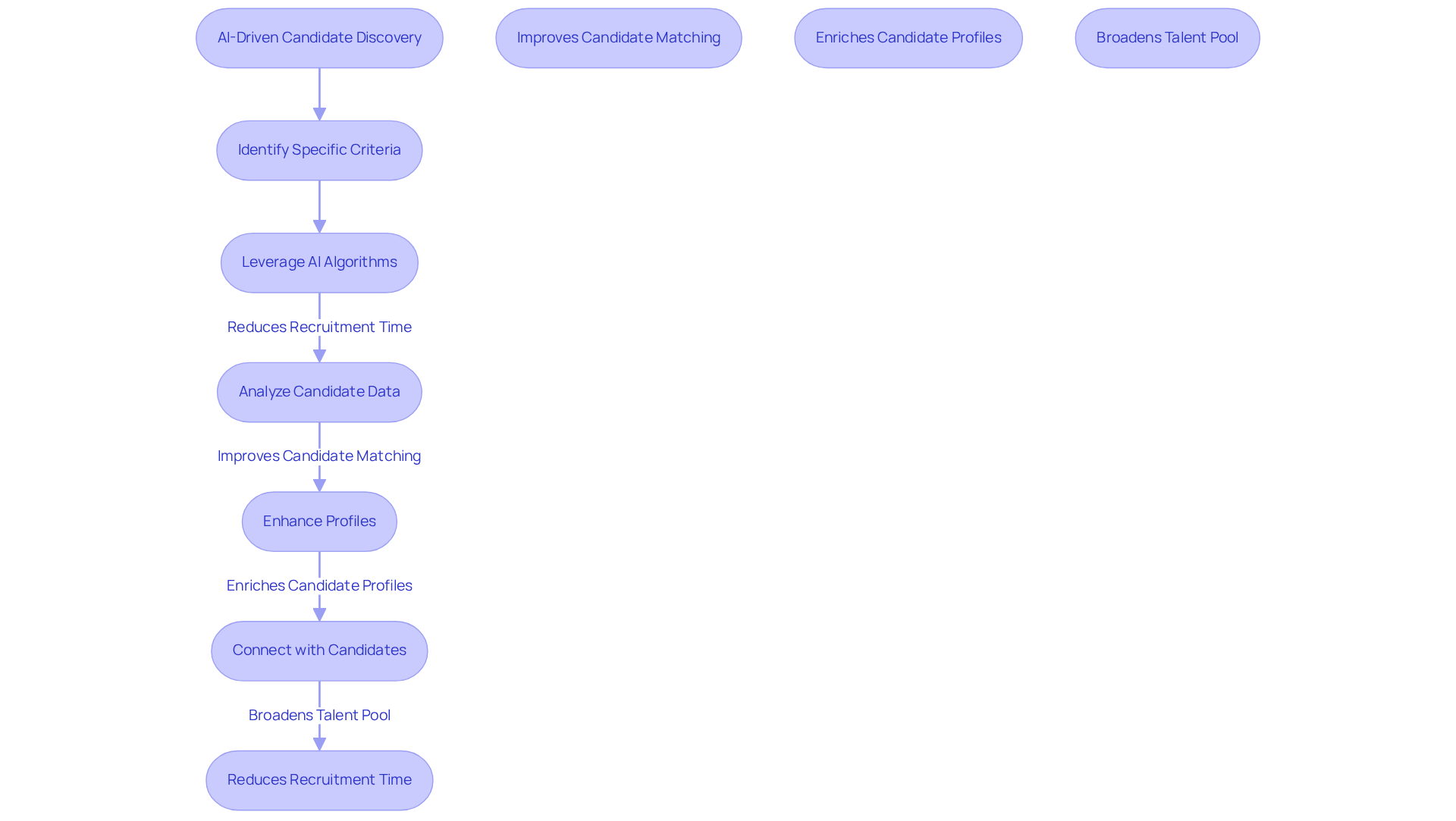
Culture-First Hiring: Align Values with Talent Acquisition
Embracing a culture-first hiring strategy is essential for organizations aiming to thrive in today's competitive landscape. By prioritizing candidates who align with the organization's core values and mission, startups can cultivate a workforce that embodies their ethos. A deep understanding of company culture, effectively communicated throughout the recruitment process, not only attracts like-minded individuals but also fosters a sense of belonging and commitment among employees. Consequently, organizations witness higher retention rates and a more engaged workforce.
Research indicates that 77 percent of prospective employees consider a company's culture before applying, underscoring the critical role of cultural alignment in attracting high-quality talent. Successful startups recognize the importance of recruiting individuals who reflect their values. This strategic approach and drives innovation and performance. Steve Jobs famously asserted that hiring the best individuals is crucial for any organization, reinforcing the notion that cultural fit is vital for long-term success.
By focusing on cultural fit and embracing the concept of 'Culture Add,' companies can create a thriving environment conducive to growth and employee satisfaction. This proactive stance not only positions organizations for success but also empowers them to navigate the challenges of recruitment effectively.
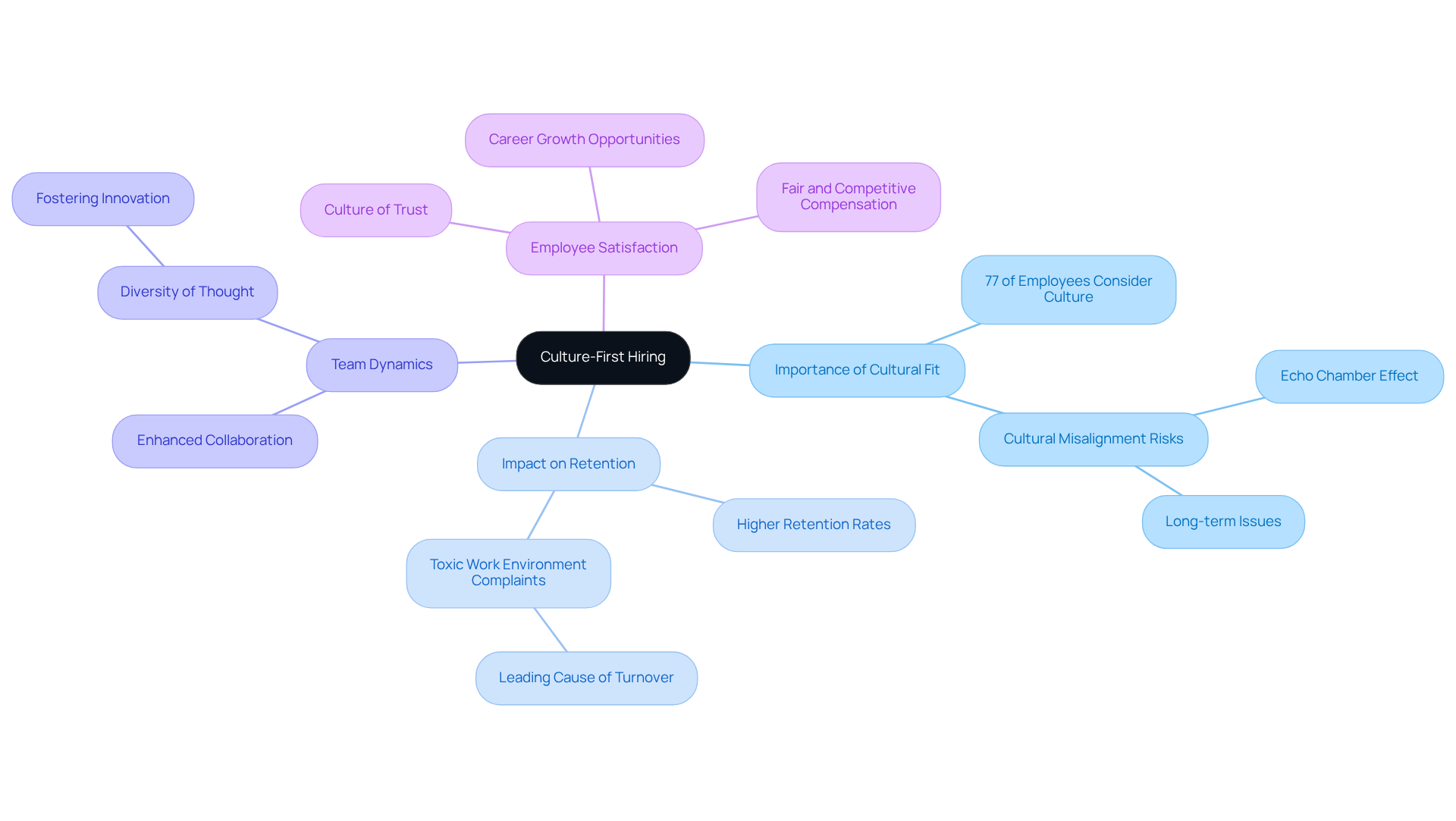
Network-Based Recruitment: Tap into Existing Connections for Talent
Network-based recruitment leverages existing connections to source candidates, significantly enhancing the quality of hires. Startups can motivate employees to recommend individuals from their networks, resulting in a greater likelihood of attracting top talent. Statistics reveal that referred applicants are four times more likely to be hired compared to those acquired through conventional methods, underscoring the efficiency of this strategy.
By actively participating in industry networking events and nurturing connections, startups can broaden their talent pool and streamline the hiring process, thereby increasing their startup hiring velocity as a growth signal. This approach not only saves time—reducing the average time-to-hire by up to 10 days—but also serves as a startup hiring velocity as a growth signal, fostering a sense of community and collaboration within the organization. For instance, organizations like Fairview have successfully sourced numerous hires through structured referral programs, illustrating the tangible benefits of network-based recruitment.
Moreover, leveraging Websets' AI-driven solutions can further enhance this process by optimizing the referral system and improving talent sourcing. A robust employee referral program can elevate employee engagement and morale, acting as a startup hiring velocity as a growth signal, as individuals feel empowered to contribute to their organization’s growth. This collaborative environment not only attracts but also enriches the overall company culture, creating a win-win for both staff and employers. However, it is essential to recognize potential downsides, such as bias and workplace politics, which can emerge from employee referrals. Addressing these challenges is vital for sustaining a positive and productive hiring environment.
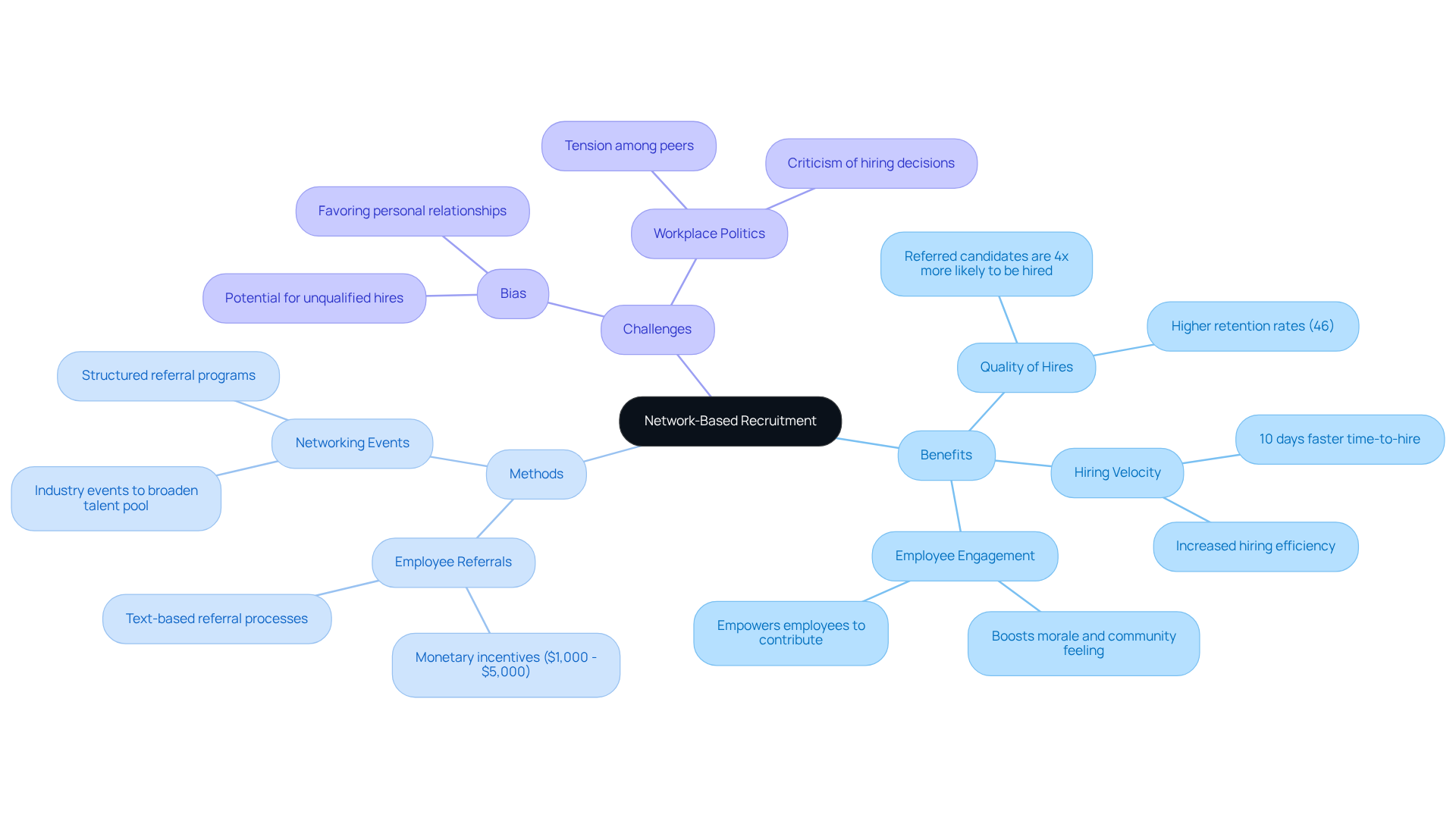
Test Projects: Assess Skills Through Real-World Simulations
Implementing test projects is a powerful strategy for startups to evaluate applicants' skills in a practical context. By assigning real-world tasks that are directly relevant to the job, employers can effectively assess how applicants approach challenges and solve problems. This method not only provides a clearer view of an applicant's capabilities but also helps identify those who are genuinely enthusiastic about the work.
Moreover, test projects can be specifically tailored to reflect the unique needs of the startup, ensuring that the evaluation process is both relevant and effective. This targeted approach not only enhances the but also aligns candidates' skills with the startup's objectives, ultimately reflecting the startup hiring velocity as a growth signal and fostering a more productive hiring process.
Slow Hiring, Fast Firing: Optimize Candidate Selection
The principle of 'slow recruitment, fast firing' emphasizes the critical need for a meticulous selection process. This approach helps prevent hasty decisions that often lead to poor hires. Startups must invest time in thoroughly evaluating candidates, focusing not just on skills but also on cultural fit and long-term potential within the organization. Research shows that hiring the wrong individual can cost at least 30% of their first-year earnings; thus, careful selection is paramount.
When a new hire fails to meet expectations, is essential. This minimizes disruption and upholds team morale. Such a proactive approach not only fosters a stable and productive work environment but also enhances overall employee engagement. Companies with strong cultures experience 72% higher engagement rates—an undeniable advantage.
By prioritizing a structured hiring process, startups establish a strong foundation for success, utilizing startup hiring velocity as a growth signal. The optimization of hiring velocity is recognized as a startup hiring velocity as growth signal, guiding organizations toward a more prosperous future.
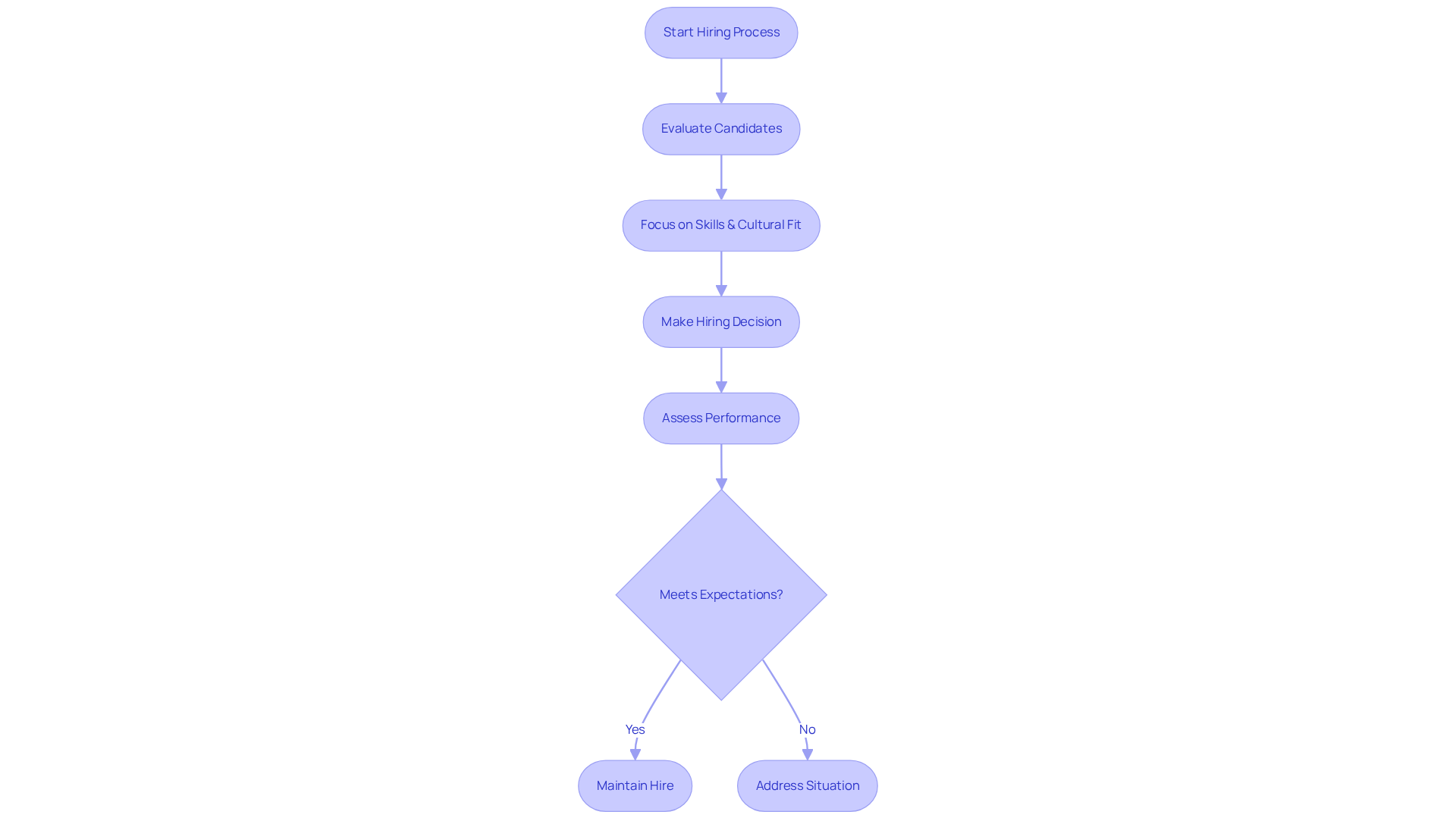
Remote-First Talent Acquisition: Expand Your Reach Beyond Borders
Embracing a remote-first strategy for talent acquisition empowers startups to tap into a global workforce, effectively dismantling geographical barriers that limit candidate selection. This approach attracts applicants with , fostering the innovation and creativity essential for growth.
Investing in technology that facilitates seamless remote collaboration is imperative, as it enables teams to operate efficiently from any location. By prioritizing flexibility and inclusivity, startups can improve their startup hiring velocity as a growth signal and establish themselves as progressive employers in a competitive landscape.
Notably, with 87% of job applicants favoring positions that offer remote options, this strategy proves invaluable in drawing top-tier talent eager for autonomy and varied work environments.
Moreover, leveraging Websets' AI-driven recruitment tools can significantly enhance this strategy, allowing for precise talent discovery and qualification through filtering by skills, experience, and location.
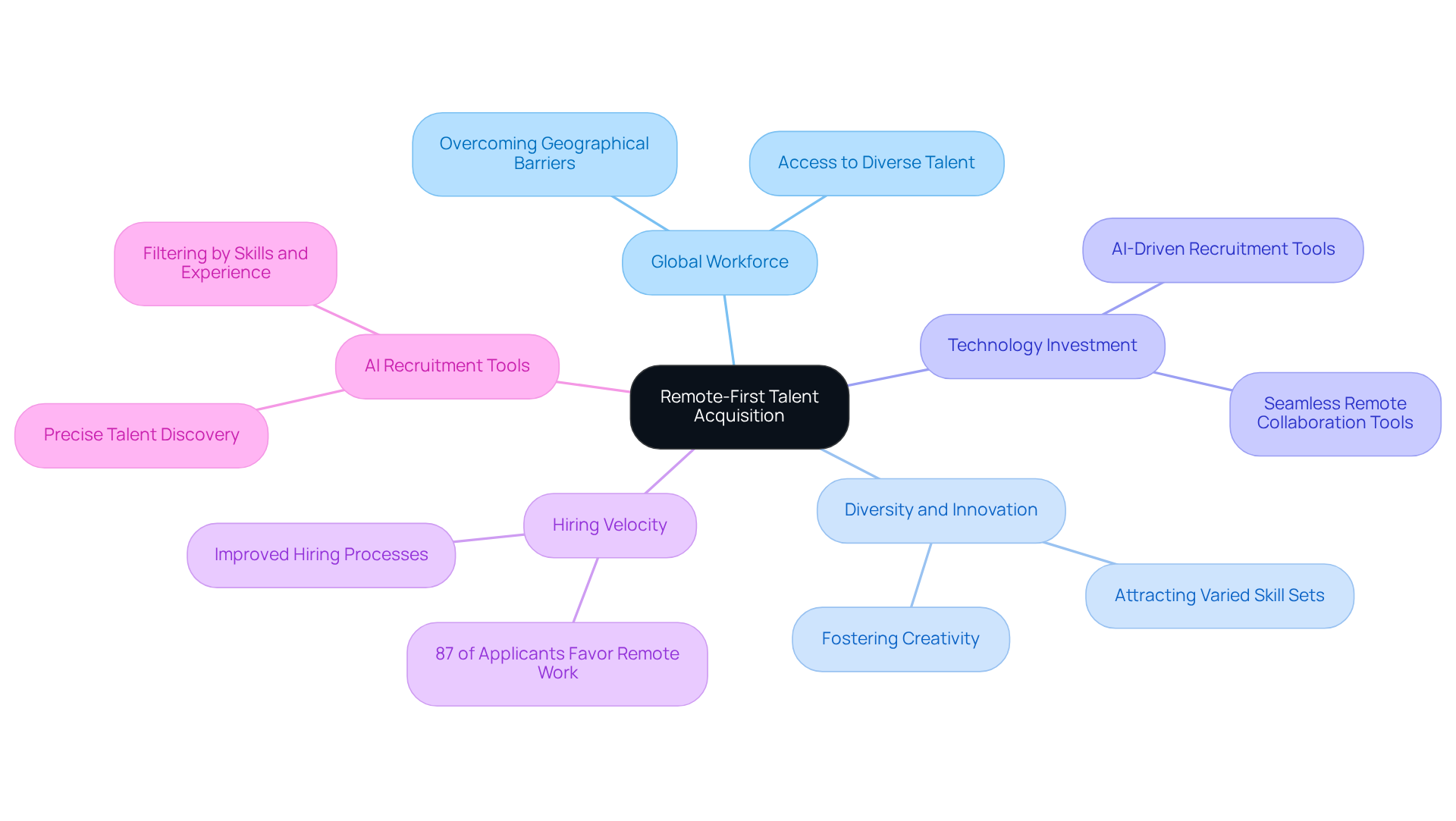
Diversity-Focused Recruitment: Build Inclusive Teams for Innovation
Diversity-focused recruitment is essential for building inclusive teams that reflect a broad spectrum of backgrounds and experiences. Startups must prioritize attracting candidates from underrepresented groups and implement strategies to mitigate bias throughout the hiring process. By cultivating an inclusive workplace culture, organizations can harness a wider array of ideas and viewpoints, crucial for driving innovation and enhancing overall performance.
This not only bolsters the organization's reputation but also draws in top talent who value inclusivity in their work environment. Research indicates that diverse teams are:
- 70% more likely to capture new markets
- Generate 19% greater innovation revenues
- Outperform individual decision-makers in business choices up to 87% of the time
This underscores the tangible benefits of inclusive employment practices.
Furthermore, organizations with diverse management teams report that:
- 45% of their total revenue originates from innovation
This illustrates how diversity serves as a powerful catalyst for growth and success. Notably, 76% of job seekers view a diverse workforce as a critical factor when assessing companies and job offers, emphasizing the competitive edge that a commitment to diversity provides.
By leveraging AI to minimize bias in recruitment, startups can further amplify their diversity initiatives and ensure a more equitable hiring process.
Hire for Potential: Invest in Future Talent
Hiring for potential requires looking beyond an applicant's current skills and experience to assess their ability to grow and adapt within the organization. Startups must prioritize candidates who show a willingness to learn and a passion for the industry. By investing in future skills, companies can cultivate a workforce that is agile and capable of meeting evolving business needs. This approach not only enhances team dynamics but also fosters a culture of and innovation.
Notably, adaptability has emerged as the most in-demand soft skill, underscoring its significance in the hiring process. As John F. Kennedy observed, effective leadership is tied to a dedication to continuous learning, which is crucial for fostering ability and navigating the complexities of today's market. Moreover, studies show that organizations with a robust learning culture experience a remarkable 57% retention rate for employees, emphasizing the long-term advantages of investing in workforce development.
In the words of Warren Buffett, acquiring knowledge and skills is an investment that yields significant returns, both financially and personally. By focusing on candidates with a growth mindset and strong soft skills, startups can leverage their startup hiring velocity as a growth signal to build a resilient and forward-thinking team capable of driving future success.
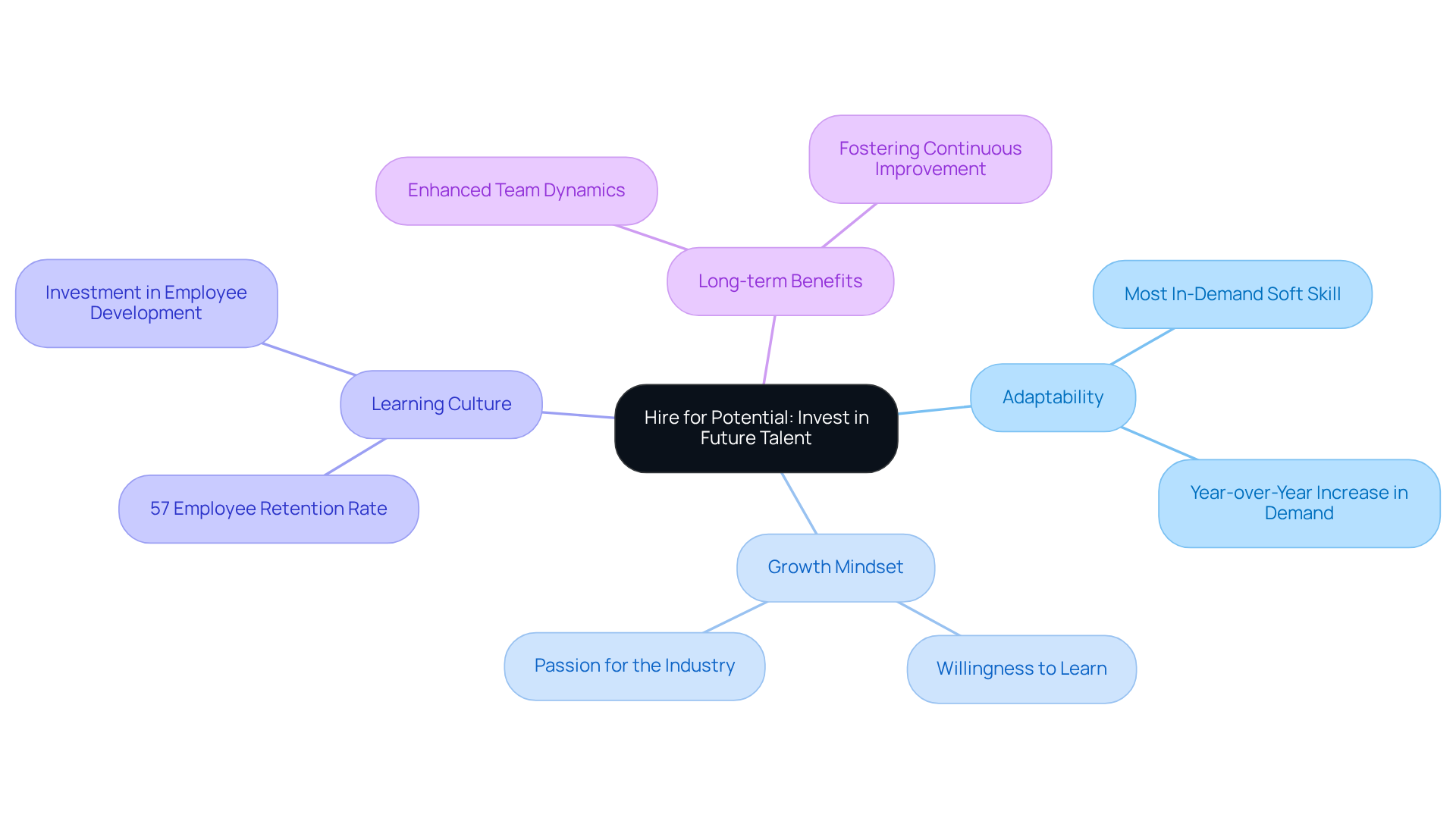
Employer Branding: Create a Compelling Company Image
Developing a strong employer brand is essential for attracting top talent in today's competitive job market. Startups must clearly convey their values, mission, and culture through various channels, including social media and organizational websites. By showcasing employee testimonials and highlighting unique features of the workplace, organizations can create a genuine image that resonates with potential candidates. A compelling employer brand not only attracts talent but also fosters loyalty and engagement among existing employees.
Statistics indicate that organizations that actively invest in their employer brand observe:
- A 50% reduction in cost-per-hire
- A 31% greater acceptance rate for job offers
Moreover, 9 out of 10 applicants would seek employment at an organization with a vibrant employer brand, underscoring its significance in the hiring process. By aligning their branding efforts with their core values and mission, startups can cultivate a positive perception that attracts high-quality candidates and fosters long-term employee commitment.
Furthermore, employees who comprehend and relate to their organization's mission and values are 67% more engaged, emphasizing the importance of clear communication in employer branding. Given that 79% of job applicants utilize social media in their job search, leveraging these platforms is crucial for enhancing employer visibility and appeal.
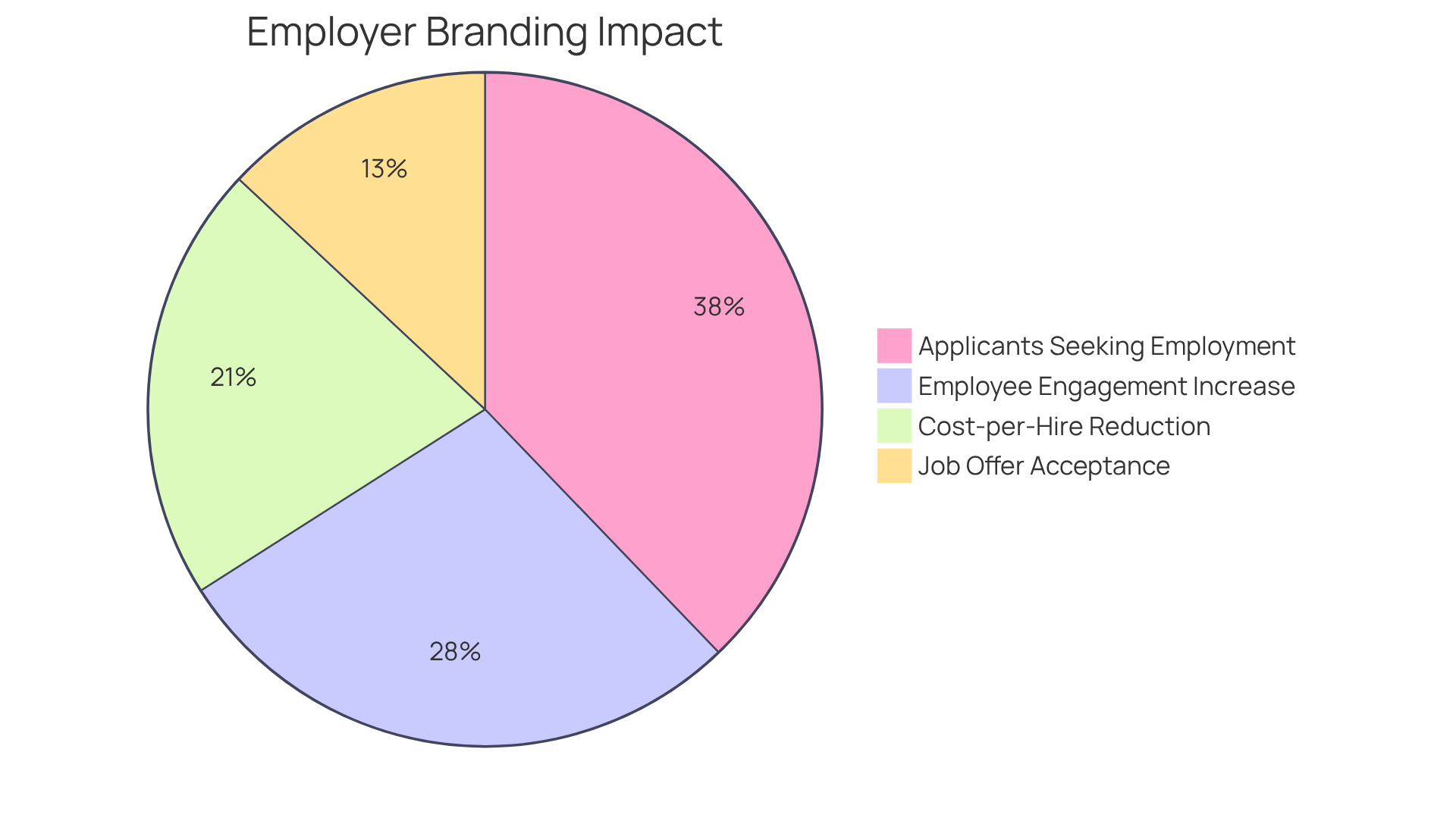
Integrate Strategies: Combine Approaches for Maximum Hiring Impact
Incorporating various recruitment strategies empowers startups to forge a robust workforce acquisition process that maximizes impact. By merging AI-driven candidate discovery with culture-first recruitment, network-based approaches, and diversity-focused initiatives, organizations can significantly enhance their effectiveness in attracting and retaining top talent. This multifaceted approach not only accelerates the filling of positions, demonstrating as a growth signal, but also cultivates a cohesive team aligned with long-term objectives.
Continuous evaluation and adaptation of these strategies are essential for optimizing outcomes, especially regarding startup hiring velocity as a growth signal. Organizations that prioritize a blend of methodologies often witness a 30% increase in application rates and a 35% boost in productivity, attributable to a more diverse workforce. Emphasizing the importance of a comprehensive recruitment strategy, experts assert that companies leveraging a combination of AI and cultural alignment are better positioned to meet the evolving demands of the job market.
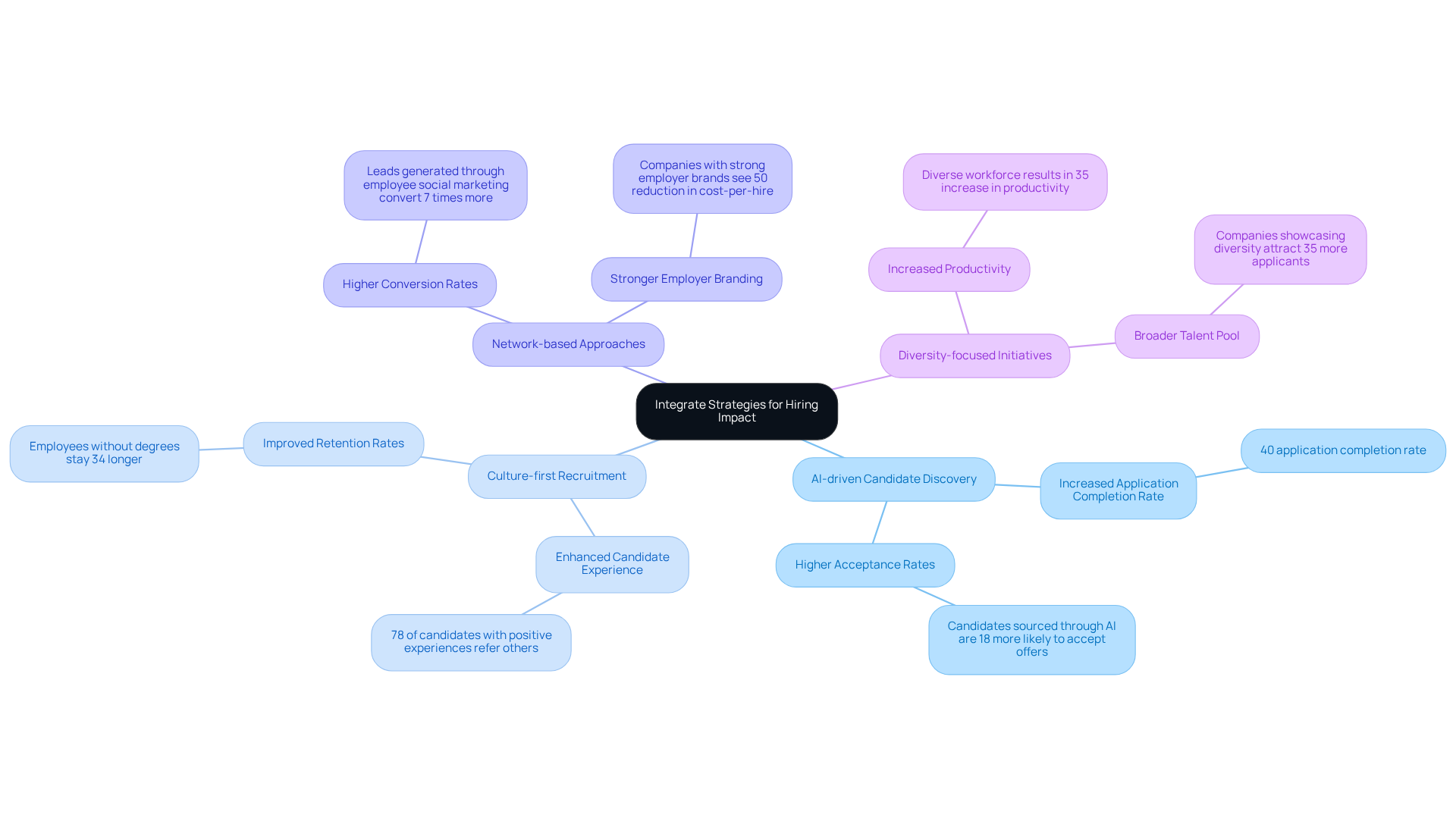
Conclusion
Boosting startup hiring velocity is essential for fostering growth and securing a competitive edge in the market. By implementing innovative strategies such as:
- AI-driven candidate discovery
- Culture-first hiring
- Network-based recruitment
startups can significantly enhance their recruitment processes. These methods not only streamline the hiring timeline but also ensure that organizations attract candidates who align with their core values and mission.
Throughout this article, several key insights have been highlighted. The integration of AI technologies can drastically reduce recruitment times and improve candidate matching accuracy. Culture-first hiring cultivates a cohesive workforce that embodies the organization’s ethos, while leveraging existing networks for recruitment taps into a wealth of potential talent. Additionally, focusing on diversity and hiring for potential fosters innovation and adaptability—essential elements for long-term success.
Ultimately, the strategies outlined emphasize the importance of a holistic approach to recruitment. Startups should consider combining various methods to maximize their hiring impact, thereby creating a dynamic and inclusive work environment. By prioritizing these strategies, organizations can not only improve their hiring velocity but also build a resilient team equipped to thrive in an ever-evolving landscape. Embracing these practices will position startups for sustainable growth and success in the competitive business arena.
Frequently Asked Questions
What is Websets and how does it assist in the hiring process?
Websets is a platform that revolutionizes talent discovery through advanced algorithms, enabling startups to pinpoint and connect with potential hires effectively. It leverages AI-driven sales intelligence search to navigate extensive datasets, reducing recruitment time and improving the accuracy of applicant matches.
What are the benefits of using AI in recruitment?
AI in recruitment simplifies candidate selection, with 92% of companies reporting benefits such as productivity gains. Additionally, 89% of HR professionals affirm that AI saves time or enhances efficiency in the recruiting process.
Can you provide an example of a company successfully using AI in hiring?
Chipotle's AI assistant 'Ava Cado' improved application completion rates from 50% to 85% and reduced recruitment timelines from 12 days to just 4, demonstrating the effectiveness of AI in recruitment.
What is culture-first hiring and why is it important?
Culture-first hiring prioritizes candidates who align with an organization's core values and mission. This strategy is essential for cultivating a workforce that embodies the company's ethos, leading to higher retention rates and a more engaged workforce.
How does company culture impact job applicants?
Research shows that 77% of prospective employees consider a company's culture before applying, highlighting the importance of cultural alignment in attracting high-quality talent.
What is network-based recruitment and how does it work?
Network-based recruitment leverages existing connections to source candidates, significantly enhancing the quality of hires. Startups can encourage employees to recommend individuals from their networks, increasing the chances of attracting top talent.
What are the advantages of employee referrals in recruitment?
Referred applicants are four times more likely to be hired compared to those acquired through conventional methods, making this strategy efficient and effective in sourcing talent.
How can Websets' AI-driven solutions improve network-based recruitment?
Websets' AI-driven solutions can optimize the referral system and improve talent sourcing, enhancing the overall recruitment process and fostering a collaborative environment within the organization.
What challenges might arise from network-based recruitment?
Potential downsides of network-based recruitment include bias and workplace politics that can emerge from employee referrals. Addressing these challenges is crucial for maintaining a positive and productive hiring environment.




